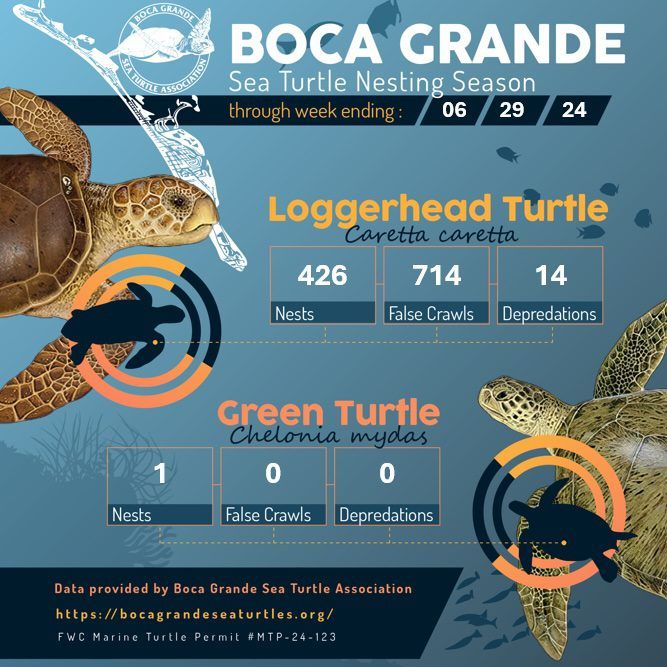Turtle report: Please stop pulling up yellow stakes protecting nests

BY ARLENE HALL
BGSTA SECRETARY
The most exciting part of turtle nesting season began last week, when hatchlings from the first couple of loggerhead nests started emerging from the sand. With the first nests laid in early May, Boca Grande turtle patrollers have started observing and documenting hatches of these nests.
As these nests begin to hatch, nesting females are still coming onto the beaches to lay more nests. Generally, nesting on Gasparilla Island will continue through the next couple of months. All this activity makes for very busy mornings for patrollers, who continue to identify and stake out new nests and false crawls, while also documenting hatches. The bright yellow stakes the turtle patrollers place by the crawls are critical for not only identifying that specific crawl, but to protect the nests from accidental trampling by enthusiastic but unaware beachgoers.

Submitted photos
Patrollers have noted a discouraging trend on our beaches this summer where a large number of our yellow stakes have been deliberately pulled or knocked out of the sand, especially in public access areas. Tampering with a sea turtle nest is illegal, and by removing stakes, it puts the nest at risk. Please do not touch or move any nest marking materials! It takes extra effort for patrollers to try to identify the exact location of that displaced stake so it can be put back. Should you accidentally knock over a stake, please put it back in the exact hole. Better yet, be careful to walk around those bright yellow stakes!
Another activity that impacts a patroller’s ability to accurately document sea turtle nesting information is when someone has deliberately crossed out a sea turtle’s tracks or has taken some action to “protect” what they believe is the nest area. Once a turtle patroller has identified and documented a crawl, they will cross out the tracks to denote it has been documented. If already crossed out by a beachgoer, data won’t be collected because the patroller will believe it has already been done. When a person tries to “help protect” a possible nest by putting sticks, shells, rocks, or other materials around a crawl, they likely will inadvertently obliterate critical details patrollers use to determine if it is a nest or a false crawl. The best thing beachgoers can do if they see sea turtle tracks is to walk over (not through) them and keep a good distance from the tracks when sitting, playing or walking in the sand. Patrollers will be out early in the morning to document it and they need to be able to see as much of the original details about the crawl as possible.
The patrol encourages sea turtle fans who want to volunteer as a turtle patroller or help in other ways to visit their website at bocagrandeseaturtles.org.
They follow strict protocols when obtaining the required data about the nest and its contents, in accordance with FWC Marine Turtle Permit #24-123. More information on the hatchlings will be shared in future articles.
All activities of the Boca Grande Sea Turtle Association are conducted and authorized under FWC Marine Turtle Permit #MTP-24-123.
At Florida State Parks:
Gasparilla: 30 loggerhead
Cayo Costa: 419 loggerhead, 1 green turtles
Don Pedro: 165 loggerhead, 13 green turtles
Stump Pass: 238 loggerhead, 1 green








